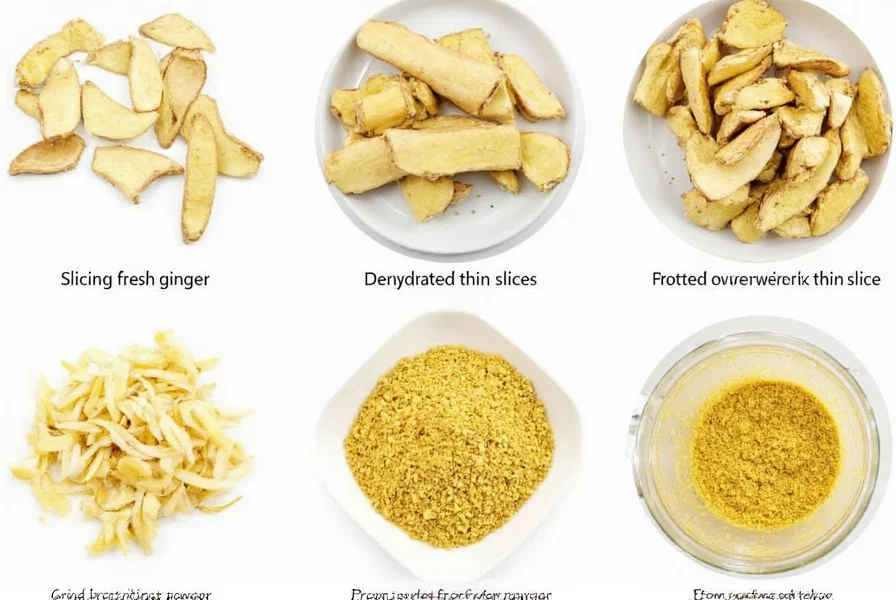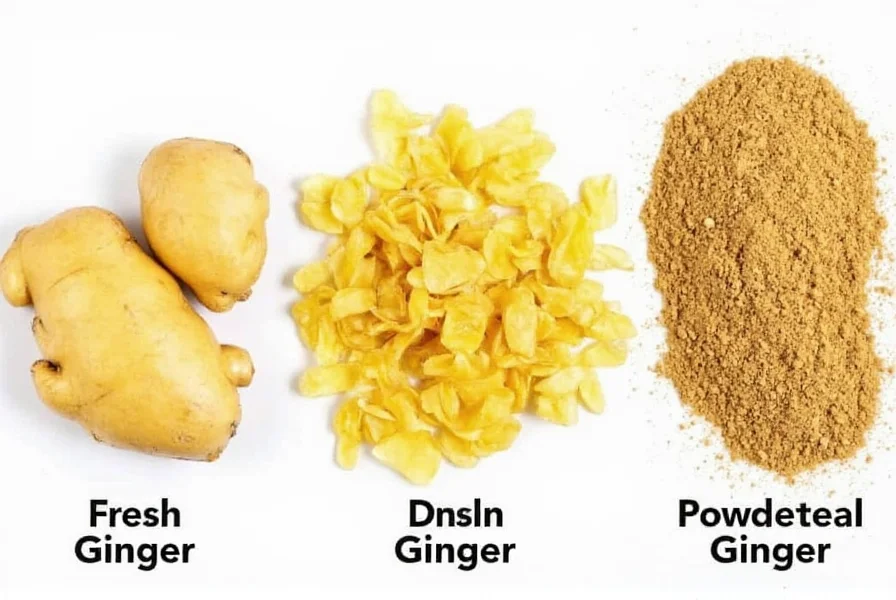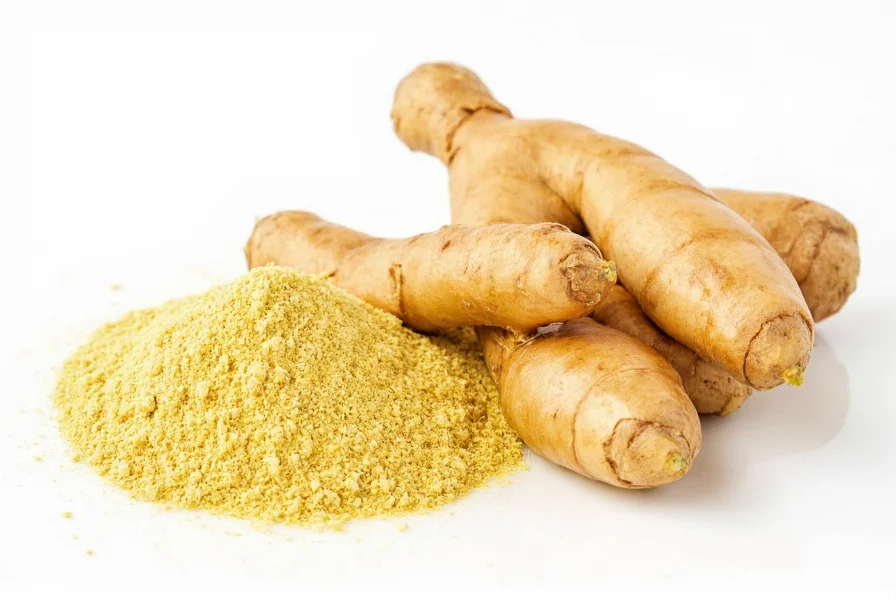When converting fresh ginger to powdered ginger, use a 6:1 ratio—6 parts fresh ginger equals approximately 1 part powdered ginger. This accounts for the 80-85% water content lost during drying. For recipe substitutions, 1 tablespoon fresh grated ginger equals about 1/4 teaspoon powdered ginger.
Understanding the precise conversion between fresh and powdered ginger is essential for consistent culinary results. The significant difference in concentration stems from fresh ginger's high moisture content. When you transform fresh ginger root into powder, you're essentially removing water while concentrating the potent gingerols and shogaols that give ginger its distinctive flavor and health properties.
The Science Behind Ginger Conversion
Raw ginger root contains approximately 80-85% water. When properly dried and ground into powder, this moisture evaporates, leaving behind concentrated ginger compounds. This fundamental transformation explains why you need substantially more fresh ginger to achieve the same flavor impact as powdered ginger.
The conversion isn't merely about volume—it's about flavor intensity and chemical composition. During the drying process, some gingerols convert to zingerone, creating subtle flavor differences between fresh and powdered forms. This chemical transformation affects both taste profile and potency.
Step-by-Step Conversion Process
Making your own powdered ginger from fresh roots ensures maximum freshness and flavor control. Here's the professional method:
- Selection: Choose firm, smooth-skinned ginger roots with no wrinkles or soft spots
- Preparation: Peel and thinly slice (⅛ inch thick) or julienne the ginger
- Drying: Dehydrate at 135°F (57°C) for 8-12 hours until completely brittle
- Grinding: Process in a spice grinder or mortar and pestle to fine powder
- Storage: Keep in an airtight container away from light and moisture
| Measurement | Fresh Ginger | Powdered Ginger |
|---|---|---|
| Basic Ratio | 6 parts | 1 part |
| Teaspoon Equivalent | 1½ tsp grated | ¼ tsp powder |
| Tablespoon Equivalent | 1 tbsp grated | ¼ tsp powder |
| Cup Equivalent | 1 cup grated | 2-3 tbsp powder |
Practical Substitution Guidelines
When substituting between forms in recipes, consider these professional tips:
- Baking applications: Powdered ginger provides more consistent flavor distribution in dry ingredients
- Asian cuisine: Fresh ginger offers brighter, more complex notes in stir-fries and sauces
- Adjust for potency: Older powdered ginger loses potency—smell before using to gauge strength
- Liquid recipes: Add fresh ginger early to allow flavors to infuse; powdered ginger can be added later
For medicinal applications, fresh ginger contains higher levels of gingerol, while dried ginger has more shogaol—which some studies suggest has different bioavailability. This distinction matters when preparing ginger for specific health purposes.

Storage and Shelf Life Comparison
Proper storage significantly impacts both forms' longevity and potency:
- Fresh ginger: Lasts 3-4 weeks refrigerated in a paper bag, or up to 3 months frozen
- Homemade powder: Maintains peak potency for 6-12 months in airtight containers
- Commercial powder: Typically remains potent for 2-3 years when stored properly
Test powdered ginger's freshness by rubbing a small amount between your fingers—if you can't detect strong aroma, it's time to replace it. Fresh ginger should feel firm with smooth skin; wrinkled or soft spots indicate degradation.
When to Choose Fresh vs. Powdered
Understanding which form works best for specific applications elevates your cooking:
- Use fresh ginger when: You want bright, spicy notes in marinades, Asian dishes, or fresh juices
- Use powdered ginger when: Creating spice blends, baked goods, or recipes requiring even distribution
- Consider both when: Building complex flavor profiles—many professional chefs use both forms in layered recipes
For tea preparation, fresh ginger provides more nuanced flavor, while powdered offers convenience and consistent strength. In curries, fresh ginger creates brighter top notes while powdered contributes deeper background warmth.

Maximizing Flavor in Both Forms
Professional techniques for getting the most from your ginger:
- Fresh ginger: Freeze whole roots, then grate frozen—this maximizes juice release without fibrous bits
- Powdered ginger: "Bloom" in warm oil or liquid for 30 seconds before adding other ingredients
- For baking: Combine both forms—powder in dry ingredients, fresh in wet mixture
- To revive old powder: Lightly toast in dry pan before use to reactivate essential oils
When making your own powdered ginger, select mature roots with strong aroma for best results. The fibrous nature of ginger means a high-quality spice grinder yields finer powder than standard blenders. Sifting the ground ginger through a fine mesh removes any remaining fibrous particles for professional-quality powder.
What's the exact conversion for fresh ginger to powdered ginger in recipes?
The standard conversion is 1 tablespoon of freshly grated ginger equals ¼ teaspoon of powdered ginger. This 4:1 ratio accounts for the water content difference. For larger quantities, 1 cup of grated fresh ginger equals approximately 3 tablespoons of powdered ginger. Remember that older powdered ginger may have lost potency, so adjust to taste.
Can I substitute powdered ginger for fresh in all recipes?
While substitution is possible, the results differ significantly. Powdered ginger works well in baked goods and spice blends where even distribution matters. Fresh ginger provides brighter, more complex flavor in stir-fries, marinades, and fresh preparations. For best results, use fresh when the recipe specifically calls for it, but you can substitute powdered in a 1:4 ratio when necessary, adjusting to taste.
How long does homemade powdered ginger last compared to store-bought?
Homemade powdered ginger maintains peak potency for 6-12 months when stored in an airtight container away from light and moisture. Commercial powdered ginger typically lasts 2-3 years due to processing methods and packaging. The key indicator is aroma—fresh powdered ginger should have a strong, spicy scent. If you can't smell it clearly when rubbed between fingers, it's time to replace it.
Why does my homemade powdered ginger have fibrous bits?
Ginger's fibrous nature can cause texture issues in homemade powder. To achieve smoother results, slice ginger very thinly (⅛ inch or less) before drying, use a high-powered spice grinder rather than a blender, and sift the ground powder through a fine mesh strainer to remove fibrous particles. Older, more mature ginger roots tend to be more fibrous, so select younger roots when possible for finer powder.
Does the conversion ratio change for medicinal ginger preparations?
Yes, medicinal preparations require more precise conversion. Fresh ginger contains higher levels of gingerol, while dried ginger has more shogaol due to the conversion during drying. For therapeutic use, the standard 6:1 ratio still applies, but effectiveness varies by application. Consult a healthcare provider for specific medicinal preparations, as bioavailability differs between fresh and dried forms.











 浙公网安备
33010002000092号
浙公网安备
33010002000092号 浙B2-20120091-4
浙B2-20120091-4